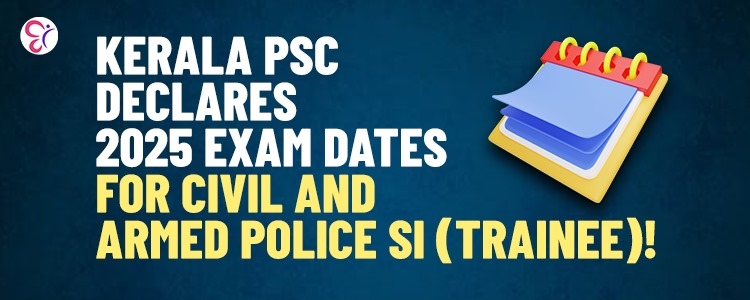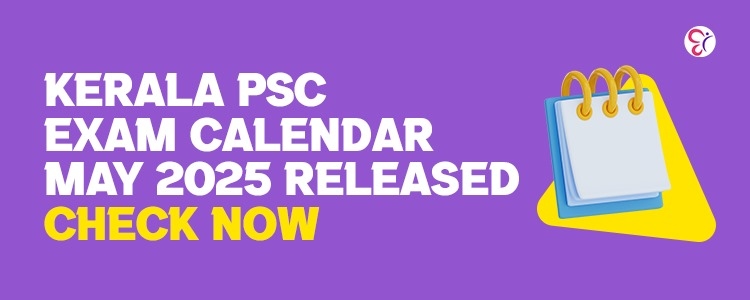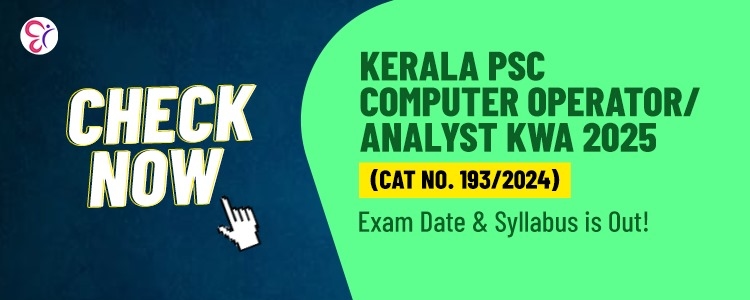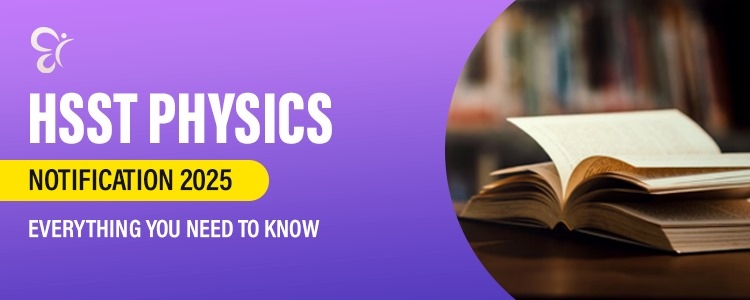Table of Contents
HSST Physics hall ticket 2025 has been released officially by the Kerala Public Service Commission on 16 June 2025. The KPSC has scheduled the HSST Physics exam date for 30 June 2025 under category number 507/2024. All the applied candidates can now download their HSST Physics hall tickets 2025 from KPSC Thulasi Login by entering their user ID and password. Do not forget that the HSST physics admission ticket 2025 is essential for writing the PSC exam. You will not be allowed into the exam hall without your hall ticket. Enhance your online PSC preparations with the best online PSC coaching app.
Overview
Kerala PSC HSST Physics Exam 2025 | |
Name of the Post | Higher Secondary School Teacher Physics |
Department | Kerala Higher Secondary Education Department |
Category Number | 507/2024 |
Statewide / District Wise | Statewide |
Kerala PSC HSST Physics 2025 Vacancy | 02 |
Kerala PSC HSST Physics Number of Applications 2025 | 4523 |
Kerala PSC HSST Physics Salary Per Month | Rs 55,200 - 1,15,300/ |
Kerala PSC HSST Physics Exam Date 2025 | 30/06/2025 Monday |
Kerala PSC HSST Physics Notification 2025 | 30/12/2024 |
Kerala PSC HSST Physics Admit Card Release Date | 16/06/2025 |
HSST Exam Time Table 2025 download Link | |
Recruitment Type | Direct |
Mode of Exam | Online OMR |
Duration | 1 Hour 30 Minutes |
Official Website | |
Kerala PSC HSST Physics Admit Card Download Link 2025
The Kerala PSC HSST Physics application deadline was 29 January 2025, following the release of the PSC HSST Physics notification on 12 December 2024. Applicants had a lengthy span of nearly five months to study and get ready for one of the esteemed teaching job exams conducted by KPSC. The Kerala PSC HSST Physics confirmation date was between 23 March 2025 and 11 April 2025. Only candidates who have submitted their confirmation will receive the admission ticket starting from 16 June 2025. If you applied for the KPSC HSST Physics 2025 but have not received your hall ticket, it means you did not confirm your attendance for the exam, and therefore, you will not be able to write the HSST Physics 2025. Candidates who have confirmed their participation can now download their Kerala HSST Physics admission ticket 2025 by logging into their KPSC profiles via the KPSC Thulasi login.
Click here for Kerala PSC HSST Physics Hall Ticket Download Link 2025
Kerala PSC HSST Physics Notification 2025
HSST Kerala PSC refers to the Higher Secondary School Teacher position in government higher secondary schools in Kerala. HSST Physics Kerala The PSC is a golden opportunity for those candidates who meet the eligibility criteria outlined in the gazette. The method of appointment for KPSC HSST Physics 2025 is through direct recruitment, which includes a test, followed by document verification and an interview. The Kerala PSC HSST Physics eligibility criteria or qualifications require a postgraduate degree and a BEd degree in physics, as well as a qualifying certificate from the State Eligibility Test (SET), organised by the Kerala government. The Kerala PSC HSST Physics age limit for the general category is set between 20 and 40 years, with relaxations available for different castes and communities.
You can check all other details regarding KPSC HSST Physics 2025, including HSST Physics recruitment, the Kerala PSC HSST Physics result, HSST Physics rank list, HSST Physics question paper, HSST Physics cut-off, HSST Physics advice, HSST Physics next exam and others from the links provided below.
- Kerala PSC HSST Physics Exam Date 2025
- Kerala PSC HSST Physics Notification 2025 : Everything You Need to Know
Kerala PSC HSST Physics Syllabus 2025
DETAILED SYLLABUS FOR THE POST OF HIGHER SECONDARY SCHOOL TEACHER - PHYSICS 2025 IN KERALA HIGHER SECONDARY EDUCATION
(Category Number - 507/2024) - TOTAL MARKS : 100
PART I - PHYSICS
1- Classical Mechanics 7 Marks
Constraints and Generalized coordinates, D'Alembert's principle and Lagrange’s equation, Velocity dependent potentials, Hamilton’s Principle, Lagrange’s equation from Hamilton’s Principle, Kepler problem, Hamilton -Jacobi equation, Hamilton‟s principal and characteristic function, H-J equation for the linear harmonic oscillator, Euler angles, Centrifugal and Coriolis forces, Nonlinear oscillations, Limit Cycles, Chaos - Logistic map.
2- Mathematical Methods and Group Theory 7 Marks
Properties of Fourier series, Fourier integral, Fourier transform, Gamma function, Beta function, Delta function, Bessel functions of the first and second kinds, Neumann function, Spherical Bessel function, Legendre polynomials, Generating function, Recurrence relation, Rodrigues formula, Orthogonality, Associated Legendre polynomials, Spherical harmonics, Hermite polynomials, Laguerre polynomials, Cauchy-Reimann conditions, Cauchy's integral theorem and integral formula, Laurent expansion, Singularities, Calculus of residues and applications.
3- Electronics and Microprocessor ( 7 +7= 14 Marks )
(a) Electronics (7 Marks )
Biasing of Field effect Transistor (FET), FET as VVR and its applications, Photodetectors - Light dependent resistor- photodiode, p-n junction solar cells, Basic operational amplifier characteristics, differential amplifier, OPAMP parameters, OPAMP as inverter, Analog integration and differentiation, Electronic analog computation, Active low pass filter, High pass Butterworth filters, Band pass filter, OPAMP based astable and monostable multivibrators, Schmidt trigger. Amplitude modulation and demodulation circuits, Comparison of signal to noise ratios, Pulse code modulation, Communications receivers, FM transmitters, VHF/UHF systems, Microwave systems , Satellite communications.
(b) Microprocessor ( 7 Marks )
Organization of microcomputers, microprocessor as CPU, Addition, Subtraction of two 8 bit & 16 bit numbers, Organization and internal architecture of the Intel 8085,Timings of Intel 8085, Data transfer schemes of Intel 8085, Applications of Microprocessors, Analog to Digital converter, Clock for A/D conversion, Sample and Hold circuit, Analog multiplexer and Overview of 8051 microcontroller.
4- Quantum Mechanics 7 Marks
Vector spaces, The Hilbert space, Operators and its properties, Angular momentum operators, Matrix representation of angular momentum operators, Pauli spin matrices, Orbital angular momentum, differential and total cross section, optical theorem, Harmonic perturbation, Interaction of an atom with the electromagnetic field, Induced emission and absorption, Anharmonic oscillator, stark and Zeeman effects in hydrogen, Hole theory, The Weyl equation. The Klein-Gordon equation, Charge and current densities.
5- Statistical Mechanics 7 Marks
The entropy of mixing and Gibbs paradox - Phase space of a classical system - Liouville‟s theorem and its consequences, Equipartition theorem - Virial theorem - The density matrix, Thermodynamic behaviour of an ideal Bose gas, Thermodynamic behaviour of an ideal Fermi gas- Magnetic behaviour of an ideal Fermi Gas : (1) Pauli paramagnetism, (2) Landau diamagnetism.
6- Nuclear and Particle Physics 7 Marks
Nuclear size, shape, mass and binding energy, semi empirical mass formula Characteristics of nuclear forces, spin - orbit potential, electric quadruple moments, parity violation in beta decay, internal conversion. Conservation laws and symmetries, Quark model, The eightfold way, quantum chromodynamics and gluons. , Fick‟s law and its validity, Shell structure and magic numbers, Single crystal and Powder diffraction, Scherrer equation, Debye-Scherrer Camera, Applications of XRD.
7-Solid State Physics 7 Marks
Miller indices, Reciprocal lattice, Brillouin zones, Einstein and Debye models of specific heat, Nearly free electron model and formation of energy bands, Bloch functions, Kronig Penny model, Dielectric constant, Local Electric field, Ferroelectric domain, Antiferroelectricity, Piezoelectricity, Langevin‟s theory of diamagnetism, Weiss theory of ferromagnetism, Neel Model of Antiferromagnetism, Type I and Type II superconductors, energy gap Isotope effect, London equation, Cooper pairs, High Tc Superconductors, Cuprates.
8-Atomic and molecular Spectroscopy 7 Marks
The spectrum of non rigid rotator, Born –Oppenheimer approximation, Normal modes and vibration of H2O and CO2, Rotational Raman Spectrum of Symmetric top molecules, stimulated Raman effect and Inverse Raman Effect. Vibrational Analysis of band systems, Deslander‟s table, Interaction of nuclear spin and magnetic field, Larmour precession, Mossbauer Spectroscopy, Resonance fluorescence of γ-rays.
9- Lasers and Fibre Optics 7 Marks
Einstein coefficients, Line-broadening mechanisms, Q-Switching, Mode locking, Four level solid state lasers, CO2 lasers, Dye lasers, Semiconductor lasers, Spatial frequency filtering and holography, Second Harmonic Generation. Acceptance angle of Optical Fibre, Numerical aperture of optical fibre, Step-index fibers, Graded index fibers. Attenuation in optical fibers, Absorption losses, Leaky modes, Radiation induced losses, Inherent defect losses.
PART II (10 Marks)
RESEARCH METHODOLOGY/TEACHING APTITUDE
I. TEACHING APTITUDE
- Teaching: Nature, objectives, characteristics and basic requirements;
- Learner's characteristics;
- Factors affecting teaching;
- Methods of teaching;
- Teaching aids;
- Evaluation systems.
II. RESEARCH APTITUDE
- Research: Meaning, Characteristics and types;
- Steps of research;
- Methods of research;
- Research Ethics;
- Paper, article, workshop, seminar, conference and symposium;
- Thesis writing: its characteristics and format.
PART III(10 Marks)
Salient Features of Indian Constitution
- Salient features of the Constitution - Preamble- Its significance and its place in the interpretation of the Constitution.
- Fundamental Rights - Directive Principles of State Policy - Relation between
- Fundamental Rights and Directive Principles - Fundamental Duties.
- Executive - Legislature - Judiciary - Both at Union and State Level. - Other
- Constitutional Authorities.
- Centre-State Relations - Legislative - Administrative and Financial.
- Services under the Union and the States.
- Emergency Provisions.
- Amendment Provisions of the Constitution.
Social Welfare Legislations and Programmes
- Social Service Legislations like Right to Information Act, Prevention of atrocities against Women & Children, Food Security Act, Environmental Acts etc. and Social
- Welfare Programmes like Employment Guarantee Programme, Organ and Blood Donation etc.
PART IV (10 Marks)
GENERAL KNOWLEDGE, CURRENT AFFAIRS AND RENAISSANCE IN KERALA TOWARDS A NEW SOCIETY
Introduction to English education - various missionary organisations and their functioning- founding of educational institutions, factories, printing press etc.
EFFORTS TO REFORM THE SOCIETY
(A) Socio-Religious reform Movements
SNDP Yogam, Nair Service Society, Yogakshema Sabha, Sadhu Jana Paripalana Sangham, Vaala Samudaya Parishkarani Sabha, Samathwa Samajam, Islam Dharma Paripalana Sangham, Prathyaksha Raksha Daiva Sabha, Sahodara Prasthanam etc.
(B) Struggles and Social Revolts
Upper cloth revolts.Channar agitation, Vaikom Sathyagraha, Guruvayoor Sathyagraha, Paliyam Sathyagraha. Kuttamkulam Sathyagraha, Temple Entry Proclamation, Temple Entry Act .Malyalee Memorial, Ezhava Memorial etc. Malabar riots, Civil Disobedience Movement, Abstention movement etc.
ROLE OF PRESS IN RENAISSANCE
Malayalee, Swadeshabhimani, Vivekodayam, Mithavadi, Swaraj, Malayala Manorama, Bhashaposhini, Mathnubhoomi, Kerala Kaumudi, Samadarsi, Kesari, AI-Ameen, Prabhatham, Yukthivadi, etc
AWAKENING THROUGH LITERATURE
Novel, Drama, Poetry, Purogamana Sahithya Prasthanam, Nataka Prashtanam, Library movement etc
WOMEN AND SOCIAL CHANGE
Parvathi Nenmenimangalam, Arya Pallam, A V Kuttimalu Amma, Lalitha Prabhu.Akkamma Cheriyan, Anna Chandi, Lalithambika Antharjanam and others
LEADERS OF RENAISSANCE
Thycaud Ayya Vaikundar, Sree Narayana Guru, Ayyan Kali.Chattampi Swamikal, Brahmananda Sivayogi, Vagbhadananda, Poikayil Yohannan(Kumara Guru) Dr Palpu, Palakkunnath Abraham Malpan, Mampuram Thangal, Sahodaran Ayyappan, Pandit K P Karuppan, Pampadi John Joseph, Mannathu Padmanabhan, V T Bhattathirippad, Vakkom Abdul Khadar Maulavi, Makthi Thangal, Blessed Elias Kuriakose Chaavra, Barrister G P Pillai, TK Madhavan, Moorkoth Kumaran, C. Krishnan, K P Kesava Menon, Dr.Ayyathan Gopalan, C V Kunjuraman, Kuroor Neelakantan Namboothiripad, Velukkutty Arayan, K P Vellon, P K Chathan Master, K Kelappan, P. Krishna Pillai, A K Gopalan, T R Krishnaswami Iyer, C Kesavan. Swami Ananda Theerthan , M C Joseph, Kuttippuzha Krishnapillai and others
LITERARY FIGURES
Kodungallur Kunhikkuttan Thampuran, KeralaVarma Valiyakoyi Thampuran, Kandathil Varghesc Mappila. Kumaran Asan, Vallathol Narayana Menon, Ulloor S Parameswara Iyer, G Sankara Kurup, Changampuzha Krishna Pillai, Chandu Menon, Vaikom Muhammad Basheer. Kesav Dev, Thakazhi Sivasankara Pillai, Ponkunnam Varky, S K Pottakkad and others.
Click here for Kerala PSC HSST Physics Syllabus 2025 PDF Download
Kerala PSC HSST Physics 2025 Online Coaching
However hard you studied, Kerala PSC HSST Physics preparation 2025 needs focused, syllabus-oriented smart work with the right guidance of Kerala PSC subject experts. The competitive Cracker app provides detailed PSC HSST preparation as well as final lap booster preparation for Kerala PSC HSST aspirants. Applicants will get the best online coaching for PSC HSST for all subjects, mock tests, discussions on HSST Physics previous question papers PDF, exam-focused practices and expert faculty support through the Competitive Cracker App. Download the Competitive Cracker App to enhance your prospects for a brighter career in the Kerala government sector.
FAQs
- Is HSST exam conducted every year in Kerala?
Ans: No. Kerala PSC conducts HSST exams for a frequent period of 3 to 4 years.
- What is the last date for HSST physics applications?
Ans: The last date for HSST Physics applications was January 29, 2025.
- What is the salary of physics teacher in Kerala?
Ans: The salary of HSST Physics teacher in Kerala ranges between ₹55,200 and ₹1,15,300.
- What is the qualification for HSST physics?
Ans: The basic qualification for HSST Physics include Post Graduation plus B Ed in physics along with SET certification.
- What is the upcoming PSC exam in Kerala in 2025?
Ans: KPSC has released many Kerala PSC notifications 2025 for upcoming PSC exams in Kerala; you can check Kerala PSC Latest Notifications 2025 for more details
Trending Updates

Related Courses
View all
March 21, 2025
Attention Aspirants: Kerala PSC Declares 2025 Exam Dates for Civil and Armed Police SI (Trainee)! Start Preparation Now
5 minute read
March 28, 2025
Attention Candidates!! Kerala PSC HSST Physics Exam Date 2025 is Out Category Number 507/2024
8 minute read
April 4, 2025
Check Now! Kerala PSC Computer Operator/Analyst KWA 2025 (Cat No. 193/2024) Exam date and Syllabus is Out!
14 minute read
December 12, 2024


